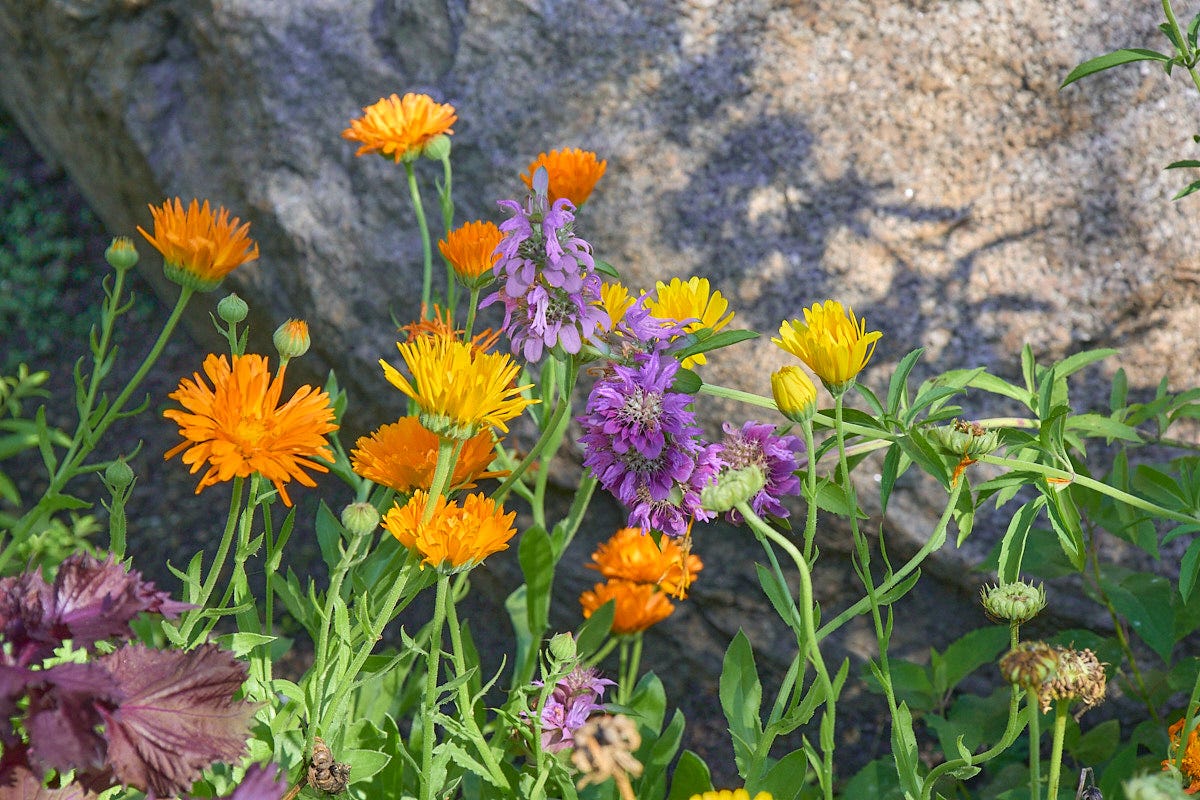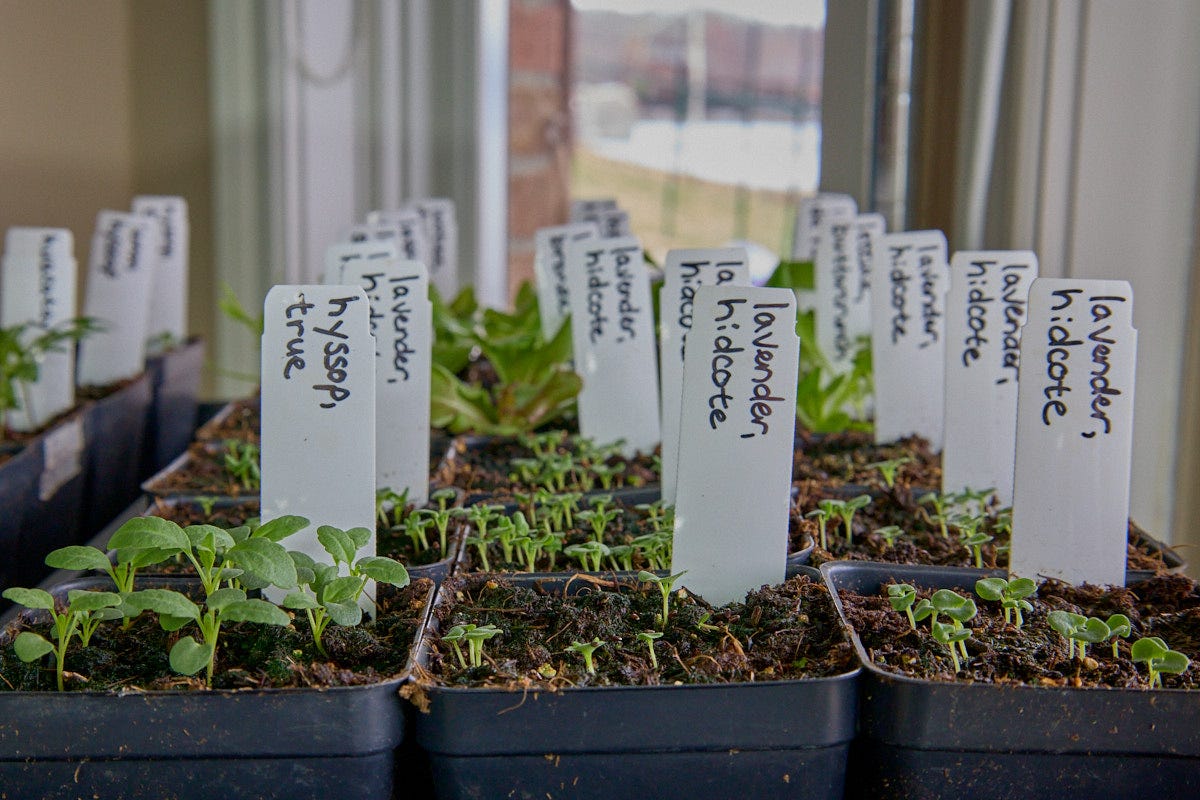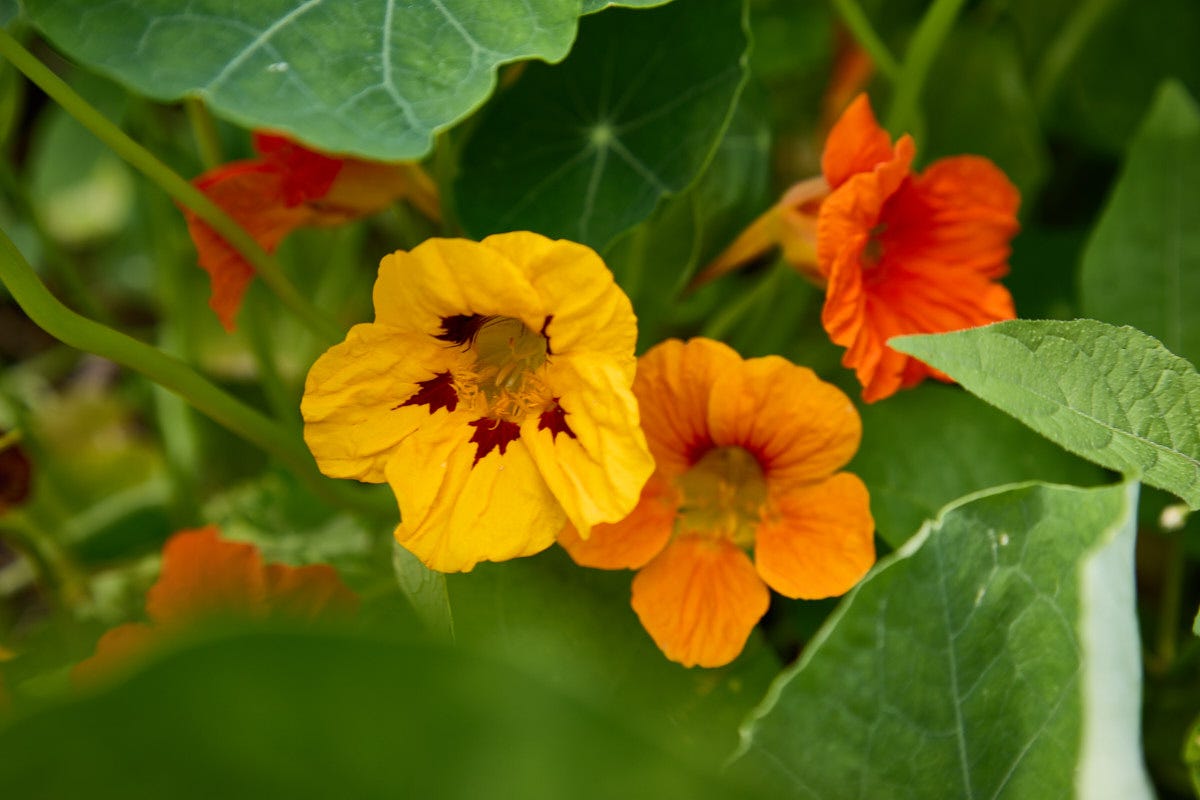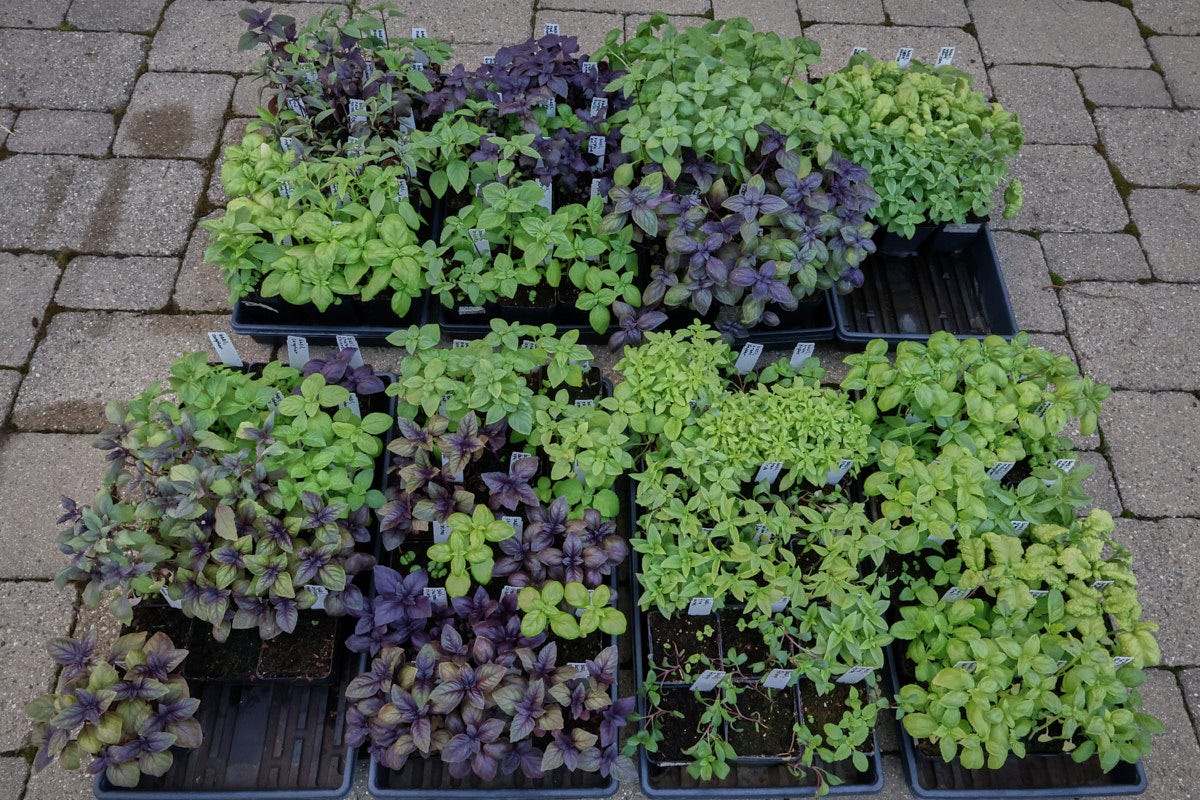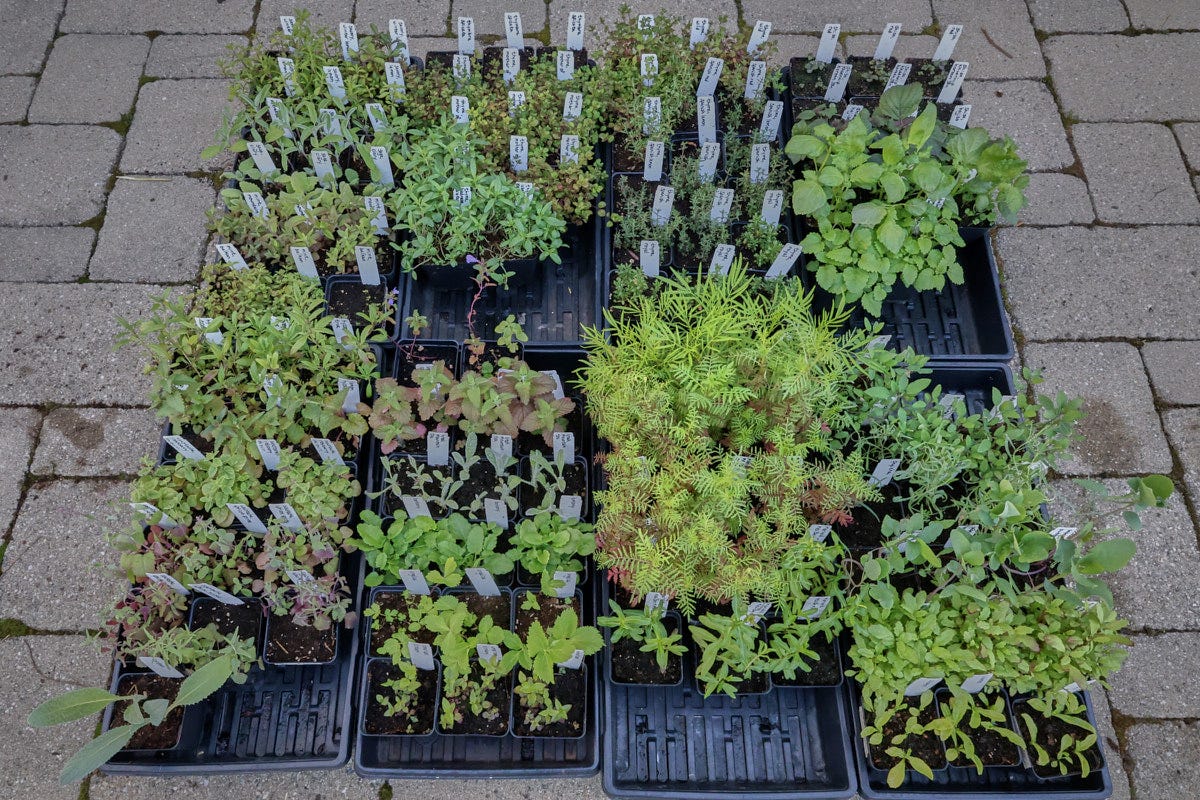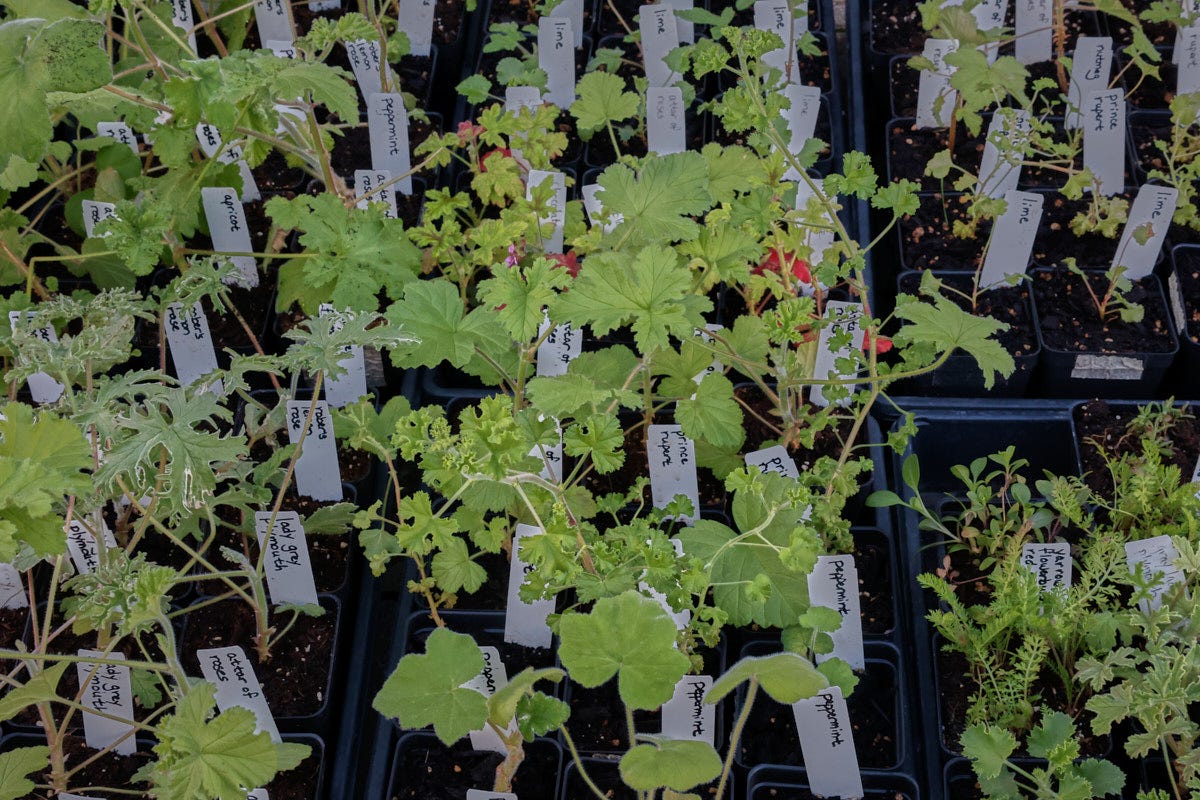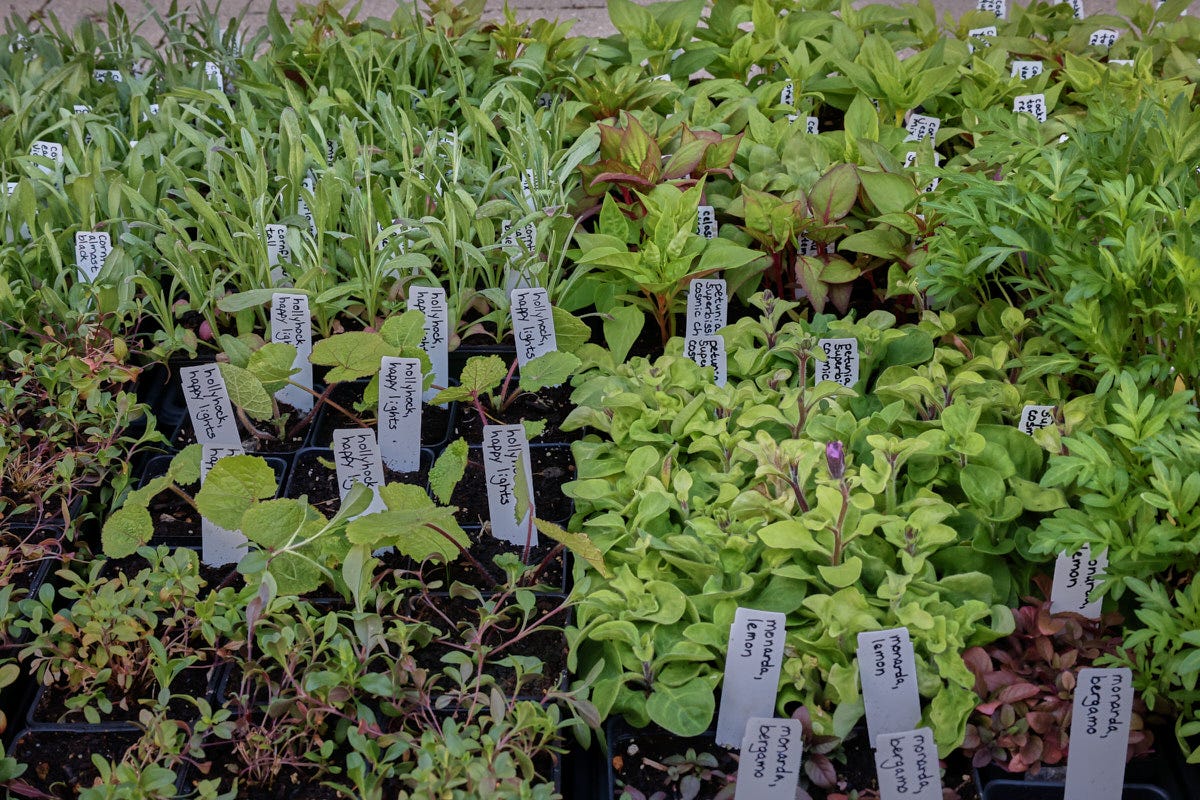It's Herb Garden Planting Time!
I'll have almost 300 varieties this year from around the world. They include returning perennials, new plants, cuttings, and seeds. Many are rare, all with exciting culinary potential to discover!
This is going to be a fantastic year in the herb garden. Among my largest categories this year are 44 new basils, 51 mints, 26 scented geraniums, and many more, including both common and rare types of global culinary herbs. I’m excited to share their incredible flavors and uses with you, both here and on my blog, Shovel and Crunch!
I’m always thrilled when the warm weather returns each spring, so I can get my hands back into the soil. But my herb garden planning starts much earlier, when the fall arrives and the next year’s plans begin. I start compiling lists in multiple spreadsheets in September. Each year I maintain separate ones for herbs, veggies, flowers, and fruit. It takes months to research rare and exciting new varieties, compare prices and vendors, and to place my orders.
I start the seeds under my grow lights in winter, adjusting the timing based on the needs of each herb, vegetable, or flower variety. There’s no better way for me to beat the winter blues than to tend and nurture these priceless vibrant tiny seedlings while they await spring planting.
After months of growing under the lights this winter and spring, my new seedlings, along with cuttings from some of last year's plants, are ready to be planted! I’ve now finished hardening them off, which means spending about a week gradually acclimating them to the real sun, wind, and outdoor temperatures. Or if I have several fully cloudy days in a row, it can take less time.
It’s difficult to determine an accurate count of the herbs I’ll be growing each year. It depends on how I decide to use them. Herbs are generally plants whose leaves or stems are eaten, while spices typically come from other parts of plants, such as roots, bark, seeds, or fruit.
For some herb types, I make sure to list each variety that I’m growing. I do this especially with types of herbs that are less familiar to me, so I really want to understand the differences among the varieties. This includes herbs like calendula or echinacea. Or there are some like dill or chervil where the differences are to me not as striking. So I’ll just lump those varieties all together and count them as one.
Some plants on my list can fit both categories, such as nasturtiums. I use both the flowers and the leaves for the delicious peppery flavor they can lend to a salad. Plus, the flowers make such a beautiful presentation:
Here’s my master list this year. It’s likely too small to read here, but this illustrates how I manage the delightful insanity of it all. If you’re interested in seeing this entire list in a more legible format, you can see it below!:
I use color coding to show which plants I’m growing in the 5 main ways I include herbs in my garden each year:
Perennials/biennials that resprout in my herb garden from the previous year
Starting from seed under my grow lights: I have 2 shelving units with six T5 grow light fixtures, one on each shelf. This gives me room for 24 flats of 18 starter pots each, for a total of 432 herb, flower, and veggie plants. Every year I do a huge self-imposed, sweaty spreadsheet battle with the numbers to fit in as many of my varieties here as I can. And then I get really greedy by adding more cold-weather varieties (like lettuce) that can go outside quickly, and will allow me to get more flats in with quick succession. And then my plant greed escalates even further when I spread out the seedlings into multiple additional flats, which I start to hoard on the floor around the light fixtures. And this year I’m planning an additional round of veggie seeds under the lights for the fall, which I normally sow directly in the ground. I don’t have a long enough growing season in my cold climate for this to be really successful for most varieties. I’ll try to get these fall seeds planted under the lights as soon as I get my spring crops in the ground. What I really need is a greenhouse!
Buying as plants: This includes varieties that may not grow from seed (like many mints, French tarragon, etc), or because I’ve run out of room under my grow lights. Sigh.
Direct sowing: herbs that grow well when planted as seeds directly into the garden
Cuttings that I take from my plants in the fall and bring inside to root over the winter and plant again in the spring
Wait-and-see varieties that haven't sprouted yet but may still appear in the garden or under the lights.
Varieties that don’t sprout, are canceled in my orders, don’t survive the season, or find some other way to make me wait another year to grow them. This is such a challenging and humbling life lesson each year! It certainly makes me appreciate the varieties I have even more.
Seedlings and cuttings I’ve started inside this year under my grow lights:
Here are 44 types of basil seedlings that I’ve grown from seed this year under my lights. These varieties are from all over the world, and are all different from those in my post last year: 38 Types of Basil You Need to Grow in Your Herb Garden. This year, I’m thrilled to introduce even more new varieties, each with unique flavors and uses in my recipes!
Annual and perennial herbs that are hard to find:
Every year I seek out rare and exciting types of herbs that are generally hard to find as seedlings in nurseries or at farmer’s markets. When possible, I order and start them from seed. This is so much more economical than buying them as plants. And it’s only way some of them are available. It’s such a delight to watch them sprout and grow under my lights during the freezing winter months.
Cuttings of scented geraniums that I grew last year to create new plants for spring. This can really save money on plants that don’t grow reliably from seed, and really help to multiply the quantities of plants.
Some flowers, many of which are edible, and which may or may not be shared my herb list (depending on their level of culinary potential):
Ok, if you’ve made it this far, I’m beyond grateful for you bearing with me! And if you’re a glutton for punishment, here’s the entire list of herbs I’ll be growing this year from the color-coded spreadsheet above. It’s going to be a thrilling year in the herb garden! (The ones with an asterisk are varieties I’m growing for the first time this year.)
Agastache:
Anise hyssop
Apache sunset
Arcado pink
Korean green
Raspberry daiquiri
Rose mint
Texas hummingbird mint
Angelica
Balm:
Lemon limoncello
Lemon Quedlinburger Niederliegende*
Lime
Orange
Variegated lemon
Basil:
African nunum*
Amethyst improved*
Ararat*
Besobela coarse*
Camphor kapoor*
Charamel chianti*
Christmas*
Crimson king*
Dark opal
East Indian (tree basil)*
Everleaf lemon*
Feleny*
Fino verde*
Floral spires*
Golden mountain sweet Thai*
Green (viride)*
Green globe
Green pepper*
Green ruffles*
Holy (This is so vague that I’m intrigued as to which one this is compared to my previously-grown specific holy ones from both India and Thailand.)*
Italian mountain sweet*
Keira*
Malawi camphor*
Mammoth sweet*
Married man pork (???)*
Napoletano
New Guinea (from 2 separate vendors with photos that look like different varieties; it’ll be fun to compare them!)*
Opalescent*
Ouzo*
Peruvian*
Punsch*
Purple delight*
Purple tulsi*
Red Freddy genovese*
Red Rubin
Reyhan Sabz*
Sacred purple (It’ll be interesting to compare to purple tulsi above, as well as my previously-grown tulsi varieties.)*
Scent leaf*
Siracusa*
Snowball*
Toscano*
Valentino*
West African*
Bay laurel
Bergamot/monarda/bee balm: (I’ve ripped out several beautiful but powdery mildew-prone varieties from last year. I’m so done dealing with this! Hopefully these ones will be much more resistant.)
Bergamo
Grand marshall*
Judith’s fancy fuchsia*
Lemon mint
Purple rooster*
Betony*
Borage
Burnet, salad
Calamintha/calamint:
Common
Dark blue panther
Grandview
Marvelette blue
Pink panther
Calendula:
Alpha
Oopsy daisy
Orange king
Pacific beauty mix
Zeolights
Catnip:
Common
Lemon
Chamomile:
German
Roman
Zloty Lan
Chervil, various types
Chives:
Common
Garlic
Nira
Profusion
Cilantro/coriander:
Rak Tamachat*
Various other types
Clove pink
Culantro (Mexican coriander)
Dill, various types
Dittany, American*
Dock, bloody
Echinacea: (I planted these last year, but they haven’t flowered yet; so I’m counting them as new to me. It’s hard to wait for that second year for perennials like this. I’m so excited to finally see the flowers!)
Cheyenne spirit*
Double decker*
Paradiso mix*
Paradiso super duper*
Pow wow wild berry*
Prairie splendor deep rose*
Elecampane, Julie’s*
Epazote:
Common
Oaxaca red*
Fennel:
Bronze
Sweet
Fenugreek:
Common
Iranian Shambalileh*
Greek mountain tea* (I tried growing this last year, but it didn’t survive into the summer. So I’m counting it as new and crossing my fingers this year!)
Horehound (a beloved nickname I like to bestow on garden-savvy friends)
Huacatay (a culinary marigold like those below, but I like to list separately)
Hyssop
lemon* (technically an agastache, like those listed above)
true*
Lavender
Ellagance pink
Ellagance purple
Hidcote
Lady
Munstead
Lemongrass
Lemon leaf*
Lemon verbena
Lovage
Marigold (Culinary varieties; this also technically includes huacatay above.)
Lemon mint*
Mexican mint/tarragon
Tangerine gem
Marjoram, sweet
Meadowsweet* (This took the all of last year to really get established, so I’m counting this as new.)
Mint: (These will make a fantastic taste test this year!)
African potato*
After eight chocolate*
Amsterdam lemon*
Apple
Arabian
Mint, Balkan*
Banana
Berries & cream
Black mitcham peppermint*
Blackcurrant*
Chewing gum*
Chinese*
Chocolate
Corsican
Costa Rican/Jamaican*
Cotton candy
Eau de cologne*
Egyptian*
English
French peppermint*
Fruit sensations
Fuzzy Chinese*
Ginger
Grapefruit
Hillary’s sweet lemon
Iced hazelnut*
Inguano*
Japanese
Julep
Kentucky colonel
Lavender*
Lime
Margarita
Marley*
Marshmallow*
Mojito
Moroccan
Hairy mountain*
Orange
Orange bergamot*
Pineapple
Scotch
Strawberry
Sweet pear
Swiss*
Thai
Vietnamese
Virginia mountain*
Water*
Wintergreen
Mitsuba:
Common
Purple
Nasturtium, several varieties
Ngo om (rice paddy plant)*
Oregano: (Please also see za’atar varieties, which I’ve listed separately below.)
Golden
Greek
Herrenhausen
Italian
Mexican*
Mexican bush*
Papalo, butterfly* (Quillquina below is also a type of papalo, listed separately.)
Parsley, Italian flat-leaf
Pepicha/pipicha*
Pelargonium (scented geranium):
Angel’s perfume*
Apple*
Apricot
Ardwick cinnamon*
Attar of roses
Chocolate mint
Cinnamon
Clorinda*
Frensham lemon*
Ginger*
Grey lady plymouth
Lemona*
Lemon crispum major*
Lime
Mabel Grey
Nutmeg
Orange fizz*
Peppermint
Prince of orange*
Prince Rupert*
Quercifolia*
Rober’s lemon rose
Scarlet unique*
Select northern pine*
Strawberry
True rose*
Quillquina (A type of papalo, which I like to list separately)
Rau ram (Vietnamese cilantro/coriander)*
Rosemary, arp
Rungia klossi (mushroom plant)*
Sage:
Clary*
Common
Extrakta*
Purple
White dalmatian
Salvia: (Some have survived and are resprouting from last year, but it’s too soon to know which ones these are. Time will tell!)
Amore purple
Blue monday sage
Rose rhapsody
Sirius blue
Sky dance
Savory:
Lemon*
Summer (aka Lebanese za’atar)
Winter
Winter lemon
Sculpit (bladder campion)*
Shiso/Perilla:
Green ohba ao
Hojiso*
Kkaennip Korean*
Purple (I’m still waiting on both these and the Vietnamese ones below; they didn’t sprout under my lights this year, but some may be coming up in the herb garden from last year’s plants reseeding)
Red
Vietnamese
Shungiku (edible chrysanthemum)*
Sorrel, profusion
Stevia, common (This year I didn’t also plant improved varieties like candy or sweetie star like in previous years, as there were too many other new things to try out and fit under my lights. Plus, stevia can be a finicky germinator.)
Sweet cicely
Sweet william
Sweet woodruff
Tarragon, French
Thyme:
Caraway
Creeping lemon
English (German, common)
French
Lavender
Lemon variegated
Lime
Mint
Orange
Orange spice
Purple carpet lemon
Rose petal
Royal
Spanish*
Spanish lemon*
Spanish red*
Spiked
Wild
Watercress
Za’atar: (I’m still waiting to see if these may have reseeded/resprouted from last year’s garden.)
Syrian Cleopatra oregano
Wild oregano
Wow, thanks for making it through this huge list! I’ll keep you posted on how these varieties grow, smell, and taste, with photos and recipes to include them in on the blog.
If you haven’t subscribed yet, please sign up for free to get more regular heirloom gardening posts like these as well as global vegan recipe posts from the blog! Thanks so much.
Shell



